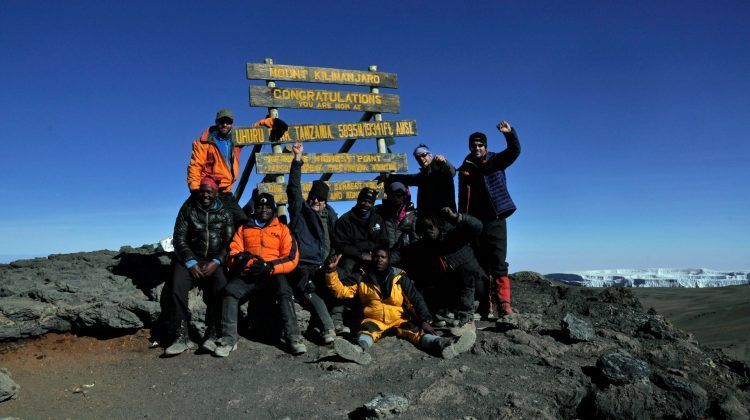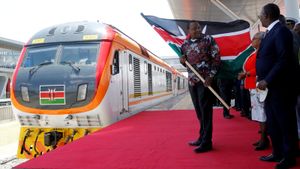Many years ago while in high school, I had embarked on climbing Kilimanjaro with my schoolmates. We did the training needed at Outward bound school in Loitokitok. The weather was so bad at the time of our training and planned climb; the Mountain school teachers deemed it unsafe for a bunch of high school students to attempt the treacherous climb. Then out of the blue about three months ago, my friend, Vicki in California, comes up and tells me that her friend’s travel company based in Los Angeles organizes trips for climbing Mount Kilimanjaro. Transported back in time I say, “It is time to take on the challenge! It is time to tackle the white elephant on my bucket list.”
In no time we loop in Mellisa, a work mate and we pay the commitment fee. The training and preparations begin. In preparing we start hiking a couple of the challenging mountains in South California, close to my residence. As we prepare we also buy all the things that are needed that include: insulated clothing, jackets and hiking shoes. I keep saying to myself you need to protect the body and keep it healthy day and night. To get to the summit of Mountain Kilimanjaro, you cannot afford to fall sick.
Having read that Mount Kilimanjaro climbing is a hike and that no specialist climbing skills are necessary other than doing a lot of hill-walking or aerobic exercise before the climb. I start to do this as I prepared for this hike. Even though stated as challenging and also dangerous, I wanted to climb to the very top.
One statement that I read was: “Climbing Kilimanjaro is probably one of the most dangerous things you will ever do. Every year, approximately 1,000 people are evacuated from the mountain, and approximately 10 deaths are reported. The actual number of deaths is believed to be two to three times higher. The main cause of death is altitude sickness.”

The six days we climbed proved the statement above to be true. Indeed, climbing Mount Kilimanjaro that is located in Tanzania, East Africa with the towns of Arusha and Moshi in the close vicinity, is a very dangerous expedition. The climb pushes the body to the extreme. To get to the highest peak, Uhuru Peak that is 5,895 meters (19,340 feet) above sea level, my mind would take over and command the body to accept that having come this far I had to get to the summit of the mountain.
Mount Kilimanjaro is the tallest free-standing mountain in Africa. It is about 700 meters taller than Mount Kenya that is 5199 m (17,057 ft). Getting to the summit means reaching and standing at the highest point possible of any mountain on land in Africa.
There are several listed climbing routes to the summit that also have their approximate distances: The Lemosho Route is 67 kilometers (41.6 miles); The Shira Route, 66 kilometers (41 miles); the Machame Route is 62 kilometers (38.5 miles) and is the most popular route up Kilimanjaro with roughly 50% of all trekkers using it; the Rongai route, the only route that starts from the Northern side of the mountain; and, the Marangu route that is the oldest and most established route up Kilimanjaro.
Our team would settle for the Lemosho Route, the most scenic of all the routes. On February 11th 2019; Myself, Vikki, Melissa, Maurice and Gladys, would arrive at Kilimanjaro National Park, Londorosi gate, that is an elevation of 7500ft above sea level. We would that day start our Mt. Kilimanjaro climb with a service crew of 23 persons. In six days, we would gradually ascend to the top of the mountain and reach the summit to the most exhilarating and breath-taking experience of my life.
I had read that point most of the persons who are challenged by the climb are defeated due to Acute Mountain Sickness (AMS), also known as altitude sickness. As a trained nurse I had carefully noted in my diary a list of the first signs for AMS: difficulty sleeping, dizziness or light-headedness, fatigue, headache, loss of appetite, nausea or vomiting, rapid heart pulse rate and shortness of breath.
As we ascended up the mountain, on day 3, at approx. 15,000 ft (almost twice the elevation at base camp), I started seeing “puppies on the snow”, some level of hallucinations, but remained fairly lucid. I also experienced some air hunger but got better over it the next couple of days as the body acclimatized to low oxygen levels. Mellisa, with whom I shared the tent works with me in Critical care unit. We both had brought with us a pulse oximeter device, so we would progressively check our oxygen saturation. At some point the determination to get to the top would be the only thought in my mind as my body muscles ached.
As we climbed Kilimanjaro the temperatures would progressively decrease as we hiked through the mountain’s different ecological zones. With the temperatures continuing to fall, the climb became the most challenging task as we put on more clothing to keep the body warm.
The climbing to the summit was the last challenge of the climb. It happened on day six. The climb is stated as a 1.2 km (1,245 m) ascent climb. This climb takes a few hours to climb as one ascends to the summit.
At the summit, Uhuru Peak, the temperatures when I reached the top were at about 10 degrees Fahrenheit (-12 degrees Celsius). The summit was also extremely windy. Reflecting that we had started the climb at about 86 degrees Fahrenheit (30 degrees Celsius) at the ground and had in six days gone through temperature changes to the freezing point was mind boggling.
Standing on the top of the Mount Kilimanjaro summit was a special moment. Looking yonder at the majestic beautiful glassier formations was breathtaking. The feeling at the Summit is truly heavenly. In the moment I stood at the summit it was an achievement like no other.
The descent was two day walk down. It was equally as challenging as the six days ascend. With every muscle at this point hurting with every single step.
The guides are excellent and very conversant will the challenges of the mountain. The porters who help carry the duffle bags and other camp items are amazing and practically relentless in what they do. Seeing them walk with us as they carried our day packs to the camp was also an encouragement. At some point they would help us carry our bags so we could be able to keep moving forward.
On average, based on the weight of a person one can burn anywhere from 300 calories to 500 calories from a one hour of hiking. The plan on how to replenish the body so as to keep going is very important. We had a first-class Chef hiking with us who would put out delicious 3 course meals every day as we progressed and camped. The chef even baked a cake as we celebrated 3 birthdays of my colleagues.
There are great stories of persons who have climbed Mount Kilimanjaro. One story is that of Dr. Robert J Wheeler, who was aged 85 years and 201 days, when he climbed the mountain. Reading this story kept me inspired as I made every step forward headed to the summit of the mountain.
We had diverse clothing wear and equipment that sustained us during the hike and during the night when sleeping in decreasing temperatures. The guides and professionals who have made this their career work knew what needed to be done. We would ascend a few feet then climb back and camp a few feet lower so the body could adjust to the oxygen levels. Hearing our lead guide had climbed the mountain more than 100 times to the Summit not only made me feel safer, but also challenged us that he had made it to the Summit 100 times.
The budget cost of climbing Kilimanjaro incorporates the services and assistance. Our team of five was serviced by a team of 23 that included the guides, chef, security and porters. I was very impressed on how the local people have organized themselves to provide services that help others maneuver the challenging climb.
The organizers and marketers who market and bring together a team enables the pooling of resources together so those desiring to climb the mountain can achieve this expedition, as well as, have a big team to support them with the food, water and other health needs during the eight days expedition.
The different camping sites that have been developed may not offer the same lodging facilities as hotels. However, they provide an experience like no other. The aching pain from the walk may torture the body, but the heavenly experience is worthy every step made to the Mount Kilimanjaro Summit.


